The weBoost Drive X (formerly 4G-X) was weBoost's flagship mobile cellular booster since its release in 2015 until the introduction of the weBoost Reach in May 2019.
It has earned its top pick status with our staff as a tried and true option, though the Reach has demonstrated superior performance in our testing.
Product Variations
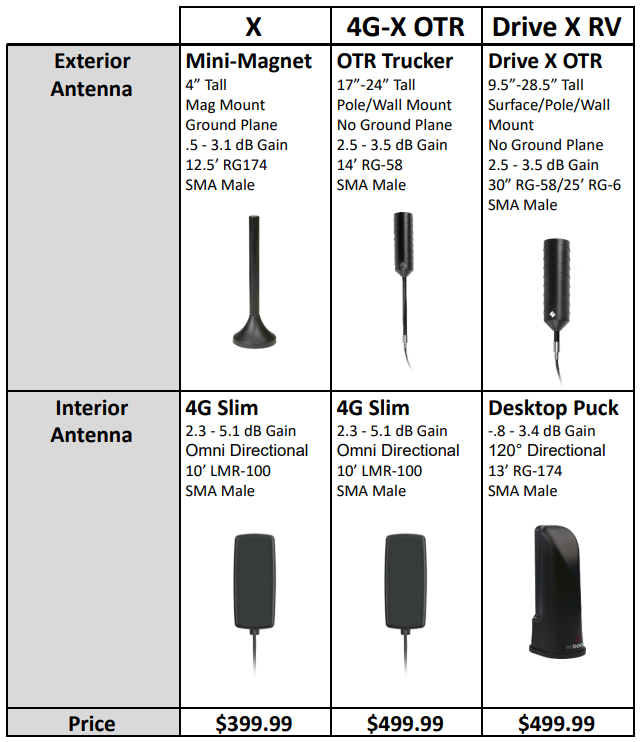 The Drive 4G-X / Drive X amplifier is available in several different antenna kit configurations, which can make selecting the right one a touch confusing.
The Drive 4G-X / Drive X amplifier is available in several different antenna kit configurations, which can make selecting the right one a touch confusing.
The kits vary mainly in the style of the antennas included, cabling, power adapters, and installation hardware. The amplifier (the black box where all of the electronics are) is exactly the same across all of the kits.
Other antenna bundles are available from some of their distributors.
Late 2019 note: weBoost rebranded the "Drive 4G-X" amplifier to "Drive X", but the amplifier itself has not changed.
RV
weBoost Drive X RV
 This kit comes packaged with the X RV Antenna and is specifically meant for installation on RVs. The antenna has a 30" integrated pigtail of low-loss LMR-195 and comes with a 25' RG-6 extension that attaches via SMA directly to the booster. It also comes with an AC and DC adapter.
This kit comes packaged with the X RV Antenna and is specifically meant for installation on RVs. The antenna has a 30" integrated pigtail of low-loss LMR-195 and comes with a 25' RG-6 extension that attaches via SMA directly to the booster. It also comes with an AC and DC adapter.
Specifications
- Model: Drive X RV - 471410
- Max Downlink Gain: 50dB
- Max Uplink Gain: 24.8 dBm
- # of Devices Boosted Simultaneously: Multiple
- LTE Bands Supported: 12 (17), 13, 5, 4, 2, 25 (partial)
- Exterior Antenna: X RV - SMA Connector
- Internal Antenna: Desktop Antenna - SMA Connector
- Power Supply: AC and DC
- Range of Interior Coverage: 6" - 4'
- In Motion Usage: Yes
- Booster Dimensions: 6.375 x 1.125 x 4.35 in
- Warranty: 2 Year
- List Price: $449.99
Vehicle
weBoost Drive X
This kit is intended for use in automobiles where the short low profile antenna can magnetically mount on vehicle's metal roof. It comes with a 12v power supply with a 'cigarette lighter' style plug, assuming no inverter or shore power is available. This unit can be used in RV and boat applications, but a ground plane will need to be supplied underneath the exterior antenna.
Specifications
- Model: Drive X - 475021
- Max Downlink Gain: 50dB
- Max Uplink Gain: 24.8 dBm
- # of Devices Boosted Simultaneously: Multiple
- LTE Bands Supported: 12 (17), 13, 5, 4, 2, 25 (partial)
- Exterior Antenna: Mini Mag Mount - SMA Connector
- Internal Antenna: 4G Slim Interior Antenna - SMA Connector
- Power Supply: DC
- Range of Interior Coverage: 6" - 4'
- In Motion Usage: Yes
- Booster Dimensions: 6.375 x 1.125 x 4.35 in
- Warranty: 2 Year
- List Price: $429.99
OTR
weBoost Drive X OTR
 This kit comes packaged with the 4G-OTR Antenna, which is basically the same as the RV antenna but includes an additional 18" extension stalk. The cabling is 15'5" LMR-195, and the kit includes a 12v power adapter. The OTR stands for 'Over the Road' and this form factor is intended for mounting to the side mirror of a semi-truck. It also might be more ideal for marine installations than the RV version for mounting to railings and getting additional height.
This kit comes packaged with the 4G-OTR Antenna, which is basically the same as the RV antenna but includes an additional 18" extension stalk. The cabling is 15'5" LMR-195, and the kit includes a 12v power adapter. The OTR stands for 'Over the Road' and this form factor is intended for mounting to the side mirror of a semi-truck. It also might be more ideal for marine installations than the RV version for mounting to railings and getting additional height.
This kit has been superceded by the Drive Reach OTR, though it is still available at weBoost and other vendors.
Specifications
- Model: Drive X OTR - 470210
- Max Downlink Gain: 50dB
- Max Uplink Gain: 24.8 dBm
- # of Devices Boosted Simultaneously: Multiple
- LTE Bands Supported: 12 (17), 13, 5, 4, 2, 25 (partial)
- Exterior Antenna: 4G-OTR - SMA Connector
- Internal Antenna: 4G Slim Interior Antenna - SMA Connector
- Power Supply: DC
- Range of Interior Coverage: 6" - 4'
- In Motion Usage: Yes
- Booster Dimensions: 6.375 x 1.125 x 4.35 in
- Warranty: 2 Year
- List Price: $449.99
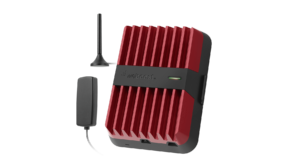
In May 2019 weBoost released the Drive Reach with even more uplink power. If you're in the market for a booster of this form factor, you may want to consider it instead as it outperformed the 4G-X in our testing.
Also, the Drive Reach offers full Band 25 support, whereas the Drive X only offers partial support for it, as noted above.
The details of our extensive head-to-head testing of the Drive X versus Reach and other boosters are available to our members.
What Does 5G Ready Mean?

Booster manufacturers may state their products are "5G ready." Which is a bit misleading. 5G is being deployed on a myriad of low, mid and high frequency bands. Current boosters only cover a handful of frequency bands in the low range spectrum (12, 13, 5, 4, 2 and sometimes 25). Where 5G is being deployed on those bands, they will work. But they will not work on the newer bands, thus only offering relatively limited 5G support.
This is a complicated topic, for more:
News, Videos & Status
We have had this booster, and many of the official kits, in our testing arsenal since August 2015.
The Drive-X OTR kits had earned their place as our reference standard that we used to test all competing boosters against it. And while it's still a solid performer, the newer Drive Reach is the new king of mobile boosters.
We have featured the Drive X with a variety of antenna combinations in the following testing rounds, and our members have access to the raw field testing data and field notes:
- Cellular Booster Intensive – weBoost Drive Reach, 4G-X, SolidRF RV Pro, Cel-Fi Go-M (Summer/Fall 2019)
- Booster Bonanza – weBoost Drive Reach, SolidRF RV Pro, Cel-Fi Go-M, Poynting 402 vs 4G-X (Summer 2019)
- Cellular Signal Field Testing – SureCall Fusion2Go 3.0 | weBoost 4G-X OTR | weBoost 4G-M | HiBoost OTR | MIMO Antennas (Late 2018)
- Cellular Signal Field Testing – SureCall Fusion2Go 3.0 | weBoost Connect RV 65 | MIMO Antennas (2nd Quarter 2018)
- Cellular Signal & Embedded Router Field Testing (1st Quarter 2018) - Featuring the new Drive Sleek and Cel-Fi Go M
- Cellular Signal Enhancing Field Testing Results (Mid 2017) - Featuring the Drive 4G-X RV Kit vs OTR and vehicle.
Our detailed hands-on review and analysis of the weBoost Drive 4G-X is featured in our members-only section below, including some member-exclusive videos.
Videos:
[/col_half][/row]
Alternatives to Consider
For other booster options on the market worth comparing this model to - here are our featured options:
Boosters are NOT the right choice for all applications.
They make the most sense for devices without antenna ports (like smartphones and tablets), or when in weak signal areas. However, for devices with antenna ports in mild to moderate signal areas - a direct-connected antenna can outperform a booster. And boosters can actually DECREASE data speeds in some conditions - never assume you need a booster on all the time - always test at each location!
For more on this:
Consider the Netgear MIMO Antenna for devices with dual antenna ports. This little antenna is worth having in your setup. It our extensive testing, it often beats out boosters for data performance in Jetpacks, MiFis and other hotspot devices.
This Review Contains Additional Member Exclusive Content!
We are Honored to be Member Funded! No ads, no sponsors, no selling (but may contain affiliate links)
Our members fund our in-depth independent reviews.
This entry may contain additional member exclusive content such as testing notes, field testing data, user interface tours, comparisons to alternatives, analysis, tips, videos and discounts.
Members also get interactive guidance, alerts, classroom and more.
Other Ways to Support Our Work At MIRC
Member Exclusive Content Below
- Thoughts & Analysis
- Deep Dive
- Performance
- LTE Bands & Network Compatibility
- weBoost Drive 4G-X Kits Compared
- Antenna Alternatives
- Changes over the Years
- Wall Mounting Tips
- Videos
- Conclusion
Purchasing Options
Purchasing Links & Disclaimer
We don't sell stuff, we are primarily member funded. Some links below may be affiliate links (see our disclaimer), which also helps fund MIRC.
The vendors displayed below provide larger discounts to our MIAs that we have negotiated instead of displaying affiliate links while they are logged in.
MIA Discounts - Learn & Save!
Our Mobile Internet Aficionados (MIA) get special discounts from the below vendors. Members please check for discount codes before ordering. With savings up to 11% off, you could save more than your membership cost!
Save 5% at weBoost.com!
While this site is not reliant on affiliate funding, our weBoost links are affiliate links (only way they'd offer us a discount code). All affiliate incomes goes towards funding this site and other great causes.
Buy Direct from weBoost (affiliate links):
Amazon: (affiliate links) Drive X | Drive X OTR | Drive X RV
Additional Vendors (members, check the Member Discount Page for discounts up to 11%):
- 5G Store: Drive X | Drive X RV
- Wilson Amplifiers: Drive X | Drive X RV |
- UberSignal: Drive X | Drive X RV
Accessories & Kits
- Power Supply Note: The X Vehicle and OTR kits come standard with a 6v power supply that plugs into a DC socket (ie. auto/cigarette lighter style). If you won't have a DC socket available or prefer to run this off of 110 AC power, you will also need to obtain a certified AC/DC supply (weBoost part 850011). The RV kit comes with both a direct wired 12v option and a plug-in AC adapter.
- Unofficial RV Kits: You'll also find some resellers who sell this unit as part of their own 'RV Kit'. These are not specifically put together by weBoost, however, they are using official weBoost components - such as different exterior & interior antennas, adapters, etc.
Cellular boosters can be quite useful for boosting the signal to a smartphone to get a more solid phone call. But when it comes to enhancing cellular data performance, things get more complicated.
Because of a technology called MIMO (multiple in multiple out) that is essential to LTE and 5G data, often times the internal antennas on a smartphone or hotspot don't benefit from an amplified signal. Boosters also only cover a handful of the frequency bands the carries use for data.
But a booster can play a role in a mobile internet arsenal - as they excel during times when you are really far from a tower, or where upload speeds are important (such as video broadcasting).
For more on understanding boosters vs. MIMO - check out video:
For more on signal enhancing, including understanding boosters and the many forms they come in - follow up with our guides:
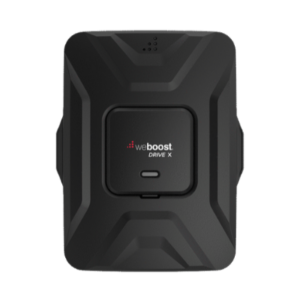
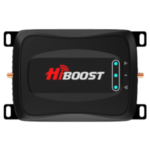





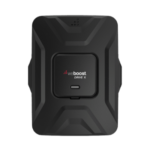




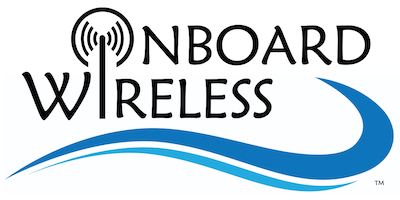



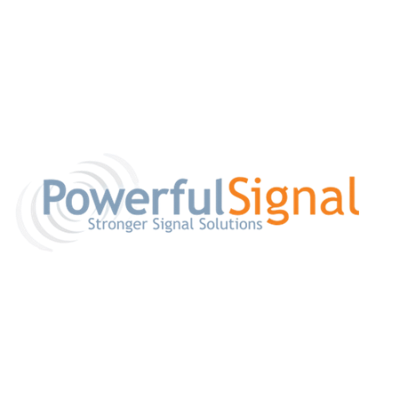


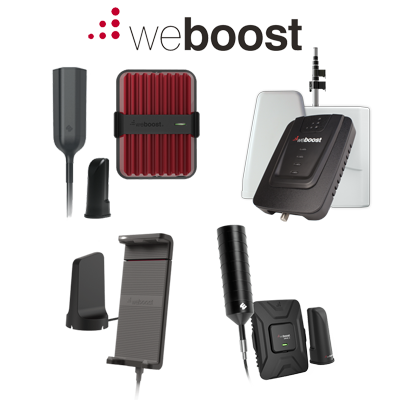

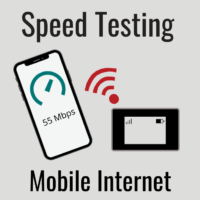
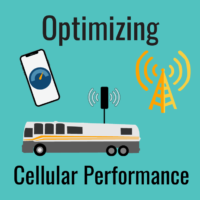
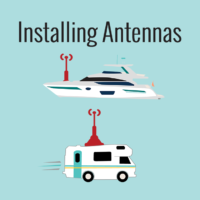










 Mobile Internet Resource Center (dba Two Steps Beyond LLC) is founded by Chris & Cherie of
Mobile Internet Resource Center (dba Two Steps Beyond LLC) is founded by Chris & Cherie of